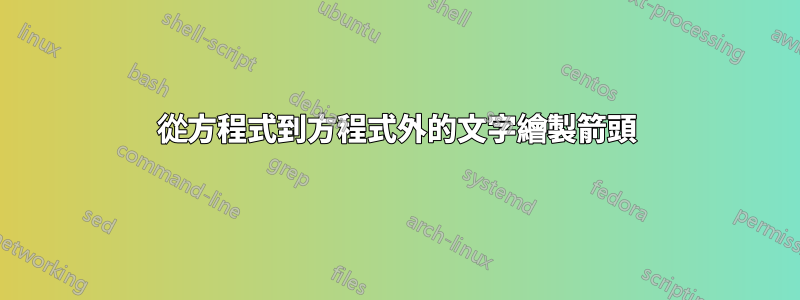
我想從方程式內部的框到方程式外部文字中的
特定部分(例如符號)繪製一個箭頭。 箭頭不應穿過文字。=
我的程式碼:
\documentclass[
pdftex,a4paper,11pt,oneside,fleqn,
bibliography=totoc,listof=totoc,
headlines=2.1,headsepline,
numbers=noenddot
]{scrreprt}
%%%----- Mathe ----------------------------------
\usepackage{amsmath,amsfonts,amssymb,bm}
\usepackage[squaren,textstyle]{SIunits}
\usepackage{icomma}
\usepackage{mathtools}
\usepackage[makeroom]{cancel}
\usepackage{trfsigns}
%%% ------ Formel schöner darstellen ------------
\usepackage{tcolorbox}
\tcbuselibrary{listings,theorems}
\def\mathunderline#1#2{\color{#1}\underline{{\color{black}#2}}\color{black}}
%%%--------------------------------------------------------
%%%----- Beginn Dokument ----------------------------------
\begin{document}
\begin{equation}
\tcbset{fonttitle=\scriptsize}
\begin{split}
\sigma_{\mathrm{n}} &= \sigma_{\mathrm{n}, \nu = 1} + \sigma_{\mathrm{n}, \nu = 1, \mu = 1} + \sigma_{\mathrm{n}, \mu = 1}\\
&= \Bigg( \dfrac{\hat{B}_{\delta \mathrm{s}, \nu = 1}^{2} + \hat{B}_{\delta \mathrm{r}, \mu = 1}^{2}}{4 \cdot \mu_{0}} + \dfrac{\hat{B}_{\delta \mathrm{s}, \nu = 1} \cdot \hat{B}_{\delta \mathrm{r}, \mu = 1}}{2 \cdot \mu_{0}} \Bigg) \cdot \Big( 1 + \cos \left(2 p \alpha - 2 \omega_{\mathrm{el}} t \right) \Big)\\
&= \dfrac{\hat{B}_{\delta \mathrm{s}, \nu = 1}^{2} + \hat{B}_{\delta \mathrm{r}, \mu = 1}^{2} + 2 \cdot \hat{B}_{\delta \mathrm{s}, \nu = 1} \cdot \hat{B}_{\delta \mathrm{r}, \mu = 1}}{4 \cdot \mu_{0}} \cdot \Big( 1 + \cos \left(2 p \alpha - 2 \omega_{\mathrm{el}} t \right) \Big)\\
&= \dfrac{\left( \hat{B}_{\delta \mathrm{s}, \nu = 1} + \hat{B}_{\delta \mathrm{r}, \mu = 1} \right)^{2}}{4 \cdot \mu_{0}} \cdot \Big( 1 + \cos \big(2 p \alpha - \tcboxmath[boxsep=1pt,left=2pt,right=2pt,top=1pt,bottom=1pt, colback=white,colframe=red]{2 \omega_{\mathrm{el}}} \, t \big) \Big) \, \text{.}
\end{split}
\label{eq: Radialkraftwelle_Grundwelle}
\end{equation}
Das Ergebnis für das Grundwellen-Luftspaltfeld ist eine Radialkraftwelle, die sich mit einer Frequenz von $f_{\mathrm{h}} = 2f_{\mathrm{el}}$ (1. Hauptordnung) ausbreitet.
\end{document}
答案1
您可以使用tikzmarks它來實現此目的。它作為 Ti 的庫提供k如果您載入了無論如何都需要的skins函式庫,Z 就會自動載入。tcolorbox使用此庫,您可以在文字中放置標記或節點,並使用tikzpicture具有選項的來引用這些標記和節點remember picture, overlay。例如,如果您將文字放置\tikzmarknode{mynode}{some text}在文字中,則稍後可以使用類似 的內容繪製一條到該節點的線\tikz \draw (mynode) -- +(0,1);。此技術可讓您從\tcboxmath方程式中的 到下面文字中公式的相關部分繪製一個箭頭。
為了能夠引用\tcboxmath,您需要新增選項enhanced, remember as=[name],這些選項僅在您skins事先載入庫時才可用。
為了讓箭頭圍繞著頁面上的文本,您可以使用該套件tikzpagenodes來引用右側的文本邊距。為了方便起見,我首先創建了一些座標,這樣可以更輕鬆地對齊箭頭。
\documentclass[
pdftex,a4paper,11pt,oneside,fleqn,
bibliography=totoc,listof=totoc,
headlines=2.1,headsepline,
numbers=noenddot
]{scrreprt}
%%%----- Mathe ----------------------------------
\usepackage{amsmath,amsfonts,amssymb,bm}
\usepackage[squaren,textstyle]{SIunits}
\usepackage{icomma}
\usepackage{mathtools}
\usepackage[makeroom]{cancel}
\usepackage{trfsigns}
%%% ------ Formel schöner darstellen ------------
\usepackage{tcolorbox}
\tcbuselibrary{listings,theorems,skins}
\def\mathunderline#1#2{\color{#1}\underline{{\color{black}#2}}\color{black}}
\usepackage{tikzpagenodes}
\usetikzlibrary{tikzmark}
%%%--------------------------------------------------------
%%%----- Beginn Dokument ----------------------------------
\begin{document}
\begin{equation}
\tcbset{fonttitle=\scriptsize}
\begin{split}
\sigma_{\mathrm{n}} &= \sigma_{\mathrm{n}, \nu = 1} + \sigma_{\mathrm{n}, \nu = 1, \mu = 1} + \sigma_{\mathrm{n}, \mu = 1}\\
&= \Bigg( \dfrac{\hat{B}_{\delta \mathrm{s}, \nu = 1}^{2} + \hat{B}_{\delta \mathrm{r}, \mu = 1}^{2}}{4 \cdot \mu_{0}} + \dfrac{\hat{B}_{\delta \mathrm{s}, \nu = 1} \cdot \hat{B}_{\delta \mathrm{r}, \mu = 1}}{2 \cdot \mu_{0}} \Bigg) \cdot \Big( 1 + \cos \left(2 p \alpha - 2 \omega_{\mathrm{el}} t \right) \Big)\\
&= \dfrac{\hat{B}_{\delta \mathrm{s}, \nu = 1}^{2} + \hat{B}_{\delta \mathrm{r}, \mu = 1}^{2} + 2 \cdot \hat{B}_{\delta \mathrm{s}, \nu = 1} \cdot \hat{B}_{\delta \mathrm{r}, \mu = 1}}{4 \cdot \mu_{0}} \cdot \Big( 1 + \cos \left(2 p \alpha - 2 \omega_{\mathrm{el}} t \right) \Big)\\
&= \dfrac{\left( \hat{B}_{\delta \mathrm{s}, \nu = 1} + \hat{B}_{\delta \mathrm{r}, \mu = 1} \right)^{2}}{4 \cdot \mu_{0}} \cdot \Big( 1 + \cos \big(2 p \alpha - \tcboxmath[enhanced,remember as=from,boxsep=1pt,left=2pt,right=2pt,top=1pt,bottom=1pt,colback=white,colframe=red,]{2 \omega_{\mathrm{el}}} \, t \big) \Big) \, \text{.}
\end{split}
\label{eq:Radialkraftwelle_Grundwelle}
\end{equation}
Das Ergebnis für das Grundwellen-Luftspaltfeld ist eine Radialkraftwelle, die sich mit einer Frequenz von $f_{\mathrm{h}} = \tikzmarknode{to}{2f_{\mathrm{el}}}$ (1. Hauptordnung) ausbreitet.
\begin{tikzpicture}[overlay, remember picture]
\coordinate (south of from) at ([yshift=-0.25cm]from.south);
\coordinate (south of to) at ([yshift=-0.25cm]to.south);
\coordinate (text margin right) at ([xshift=0.5cm]current page text area.east);
\draw[thick, red, -stealth, rounded corners=2.5pt] (from.south) -- (south of from) --
(south of from -| text margin right) -- (south of to -| text margin right) -- (south of to) -- (to.south);
\end{tikzpicture}
\end{document}




